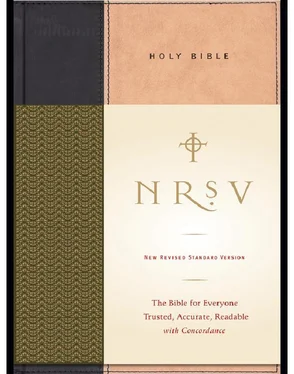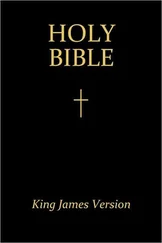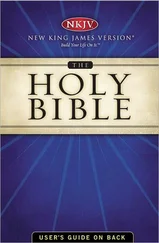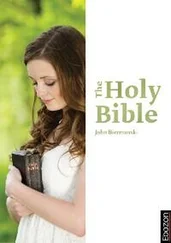During the almost half a century since the publication of the RSV, many in the churches have become sensitive to the danger of linguistic sexism arising from the inherent bias of the English language toward the masculine gender, a bias that in the case of the Bible has often restricted or obscured the meaning of the original text. The mandates from the Division specified that, in references to men and women, masculine-oriented language should be eliminated as far as this can be done without altering passages that reflect the historical situation of ancient patriarchal culture. As can be appreciated, more than once the Committee found that the several mandates stood in tension and even in conflict. The various concerns had to be balanced case by case in order to provide a faithful and acceptable rendering without using contrived English. Only very occasionally has the pronoun “he” or “him” been retained in passages where the reference may have been to a woman as well as to a man, for example, in several legal texts in Leviticus and Deuteronomy. In such instances of formal, legal language, the options of either putting the passage in the plural or of introducing additional nouns to avoid masculine pronouns in English seemed to the Committee to obscure the historic structure and literary character of the original. In the vast majority of cases, however, inclusiveness has been attained by simple rephrasing or by introducing plural forms when this does not distort the meaning of the passage. Of course, in narrative and in parable no attempt was made to generalize the sex of individual persons.
Another aspect of style will be detected by readers who compare the more stately English rendering of the OT with the less formal rendering adopted for the NT. For example, the traditional distinction between “shall” and “will” in English has been retained in the OT as appropriate in rendering a document that embodies what may be termed the classic form of Hebrew, while in the NT the abandonment of such distinctions in the usage of the future tense in English reflects the more colloquial nature of the Koine Greek used by most NT authors except when they are quoting the OT.
Careful readers will notice that here and there in the OT the word LORD (or in certain cases GOD) is printed in capital letters. This represents the traditional manner in English versions of rendering the divine name, the “tetragrammaton” (see the text notes on Exodus 3.14–15), following the precedent of the ancient Greek and Latin translators and the long-established practice in the reading of the Hebrew scriptures in the synagogue. Although it is almost if not quite certain that the name was originally pronounced “Yahweh,” this pronunciation was not indicated when the Masoretes added vowel sounds to the consonantal Hebrew text. To the four consonants YHWH of the divine name, which had come to be regarded as too sacred to be pronounced, they attached vowel signs indicating that in its place should be read the Hebrew word Adonai , meaning “Lord” (or Elohim , meaning “God”). Ancient Greek translators employed the word Kyrios (“Lord”) for the name. The Vulgate likewise used the Latin word Dominus (“Lord”). The form “Jehovah” is of late medieval origin; it is a combination of the consonants of the divine name and the vowels attached to it by the Masoretes but belonging to an entirely different word. Although the American Standard Version (1901) had used “Jehovah” to render the tetragrammaton (the sound of y being represented by j and the sound of w by v , as in Latin), for two reasons the Committees that produced the RSV and the NRSV returned to the more familiar usage of the King James Version. (1) The word “Jehovah” does not accurately represent any form of the divine name ever used in Hebrew. (2) The use of any proper name for the one and only God, as though there were other gods from whom the true God had to be distinguished, began to be discontinued in Judaism before the Christian era and is inappropriate for the universal faith of the Christian church.
It will be seen that in the Psalms and in other prayers addressed to God the archaic second-person singular pronouns (“thee, thou, thine”) and verb forms (“art, hast, hadst”) are no longer used. Although some readers may regret this change, it should be pointed out that in the original languages neither the OT nor the NT makes any linguistic distinction between addressing a human being and addressing the deity. Furthermore, in the tradition of the King James Version one will not expect to find the use of capital letters for pronouns that refer to the deity — such capitalization is an unnecessary innovation that has only recently been introduced into a few English translations of the Bible. Finally, we have left to the discretion of the licensed publishers such matters as section headings, cross-references, and clues to the pronunciation of proper names.
This new version seeks to preserve all that is best in the English Bible as it has been known and used through the years. It is intended for use in public reading and congregational worship as well as in private study, instruction, and meditation. We have resisted the temptation to introduce terms and phrases that merely reflect current moods, and have tried to put the message of the scriptures in simple, enduring words and expressions that are worthy to stand in the great tradition of the King James Bible and its predecessors.
In traditional Judaism and Christianity, the Bible has been more than a historical document to be preserved or a classic of literature to be cherished and admired; it is recognized as the unique record of God’s dealings with people over the ages. The OT sets forth the call of a special people to enter into covenant relation with the God of justice and steadfast love and to bring God’s law to the nations. The NT records the life and work of Jesus Christ, the one in whom “the Word became flesh,” as well as describes the rise and spread of the early Christian church. The Bible carries its full message not to those who regard it simply as a noble literary heritage of the past or who wish to use it to enhance political purposes and advance otherwise desirable goals, but to all persons and communities who read it so that they may discern and understand what God is saying to them. That message must not be disguised in phrases that are no longer clear or hidden under words that have changed or lost their meaning; it must be presented in language that is direct and plain and meaningful to people today. It is the hope and prayer of the translators that this version of the Bible may continue to hold a large place in congregational life and to speak to all readers, young and old alike, helping them to understand and believe and respond to its message.
For the Committee,
Bruce M. Metzger











